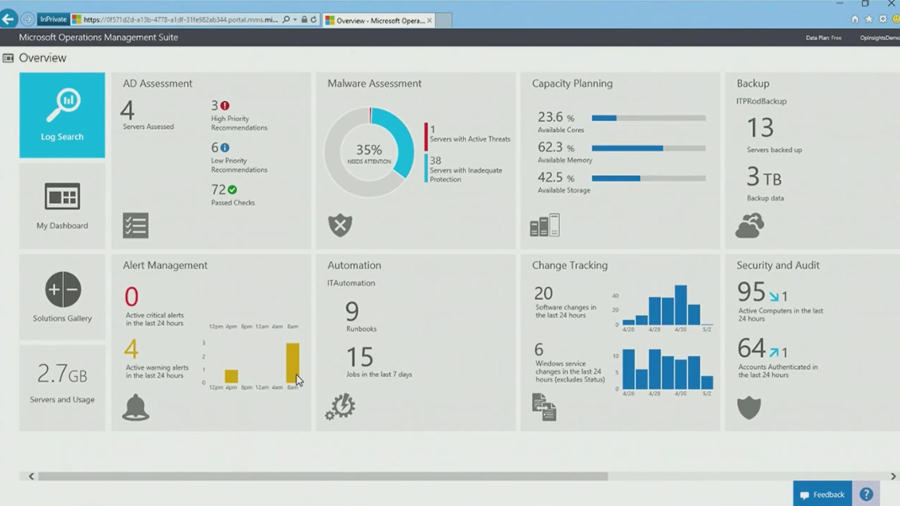Windows Server is transforming for the cloud-first world
Windows Server 2016 is being shaped by Azure's lessons

If the way the Windows Server team talks is starting to sound much more like the way the Azure team talks, and vice versa, Microsoft's Mike Neil takes that as a bit of a compliment. Last year he moved from working on Azure to running the Windows Server and System Center team.
One of his goals? "To take the learnings and the mechanics of how we do things in the public cloud and bring those to private cloud, and enhance Windows Server and provide services on top like OMS, the Microsoft Operations Management Suite, and Azure Stack as solutions."
Major changes
That's why Microsoft is talking more about the big changes like Nano Server and containers than about more traditional features such as improvements in Hyper-V and software-defined networking (both of which get significant improvements in Windows Server 2016). For one thing, he told TechRadar, that's what Windows Server users are asking for.
"The customers are more and more looking for overall solutions so they're less interested in the DIY approach where they put all the bits and pieces together themselves – they're really looking for us and our hardware partners to help produce solutions. Like Cloud Platform System – CPS is the fully integrated stack with hardware and storage and networking and our software sitting on top of that fully setup and running for you. That type of solution is really resonating with customers."
There's also the fact that hybrid cloud is a key area for Microsoft. "At a very top level, hybrid is one of the three critical differentiating factors for what we're doing: hybrid, hyperscale and enterprise grade. It is core to what we do; how do we really make hybrid a true value for the customers? It's not as simple as 'I have good connectivity to my data centre' or 'I have a single sign-on solution' – it's how do we build those applications?"
Microservices architecture
A lot of that comes down to the shift that's going on in terms of business applications – instead of a monolithic line of business applications running entirely on your own servers, the trend is to integrate with cloud services and use microservices and containers for your application architecture (and the reason you want servers at all is to run applications on them).
"Microservices as an architecture is generally adopted now," Neil points out, "and it feels like it's solidified in the developer community as the architectural choice, supplanting SOA and some of the previous generations of that.
Sign up to the TechRadar Pro newsletter to get all the top news, opinion, features and guidance your business needs to succeed!
"The challenge is, if you're an IT pro working in the enterprise, how do you deal with this kind of situation? Your CSO is coming after you on compliance and you have to check off all the check boxes when you report back to the CFO – one of the things that Microsoft can provide is a solution that meets both ends of the developer and the ops spectrum."
For the developer, he expects containers in Windows Server 2016 to be appealing; both the Docker-style containers and the more manageable Hyper-V containers. "You have this ability to share – I can share the underlying kernel and I get density improvements and I get agility from that but when I need to then go and upgrade the kernel, now I need to tease those things apart. That's really what drove us to build both solutions.
"The Hyper-V containers give us that ability to have independent lifecycle management for the containers. Especially as an app transitions from devops to ops, that becomes critical, you're going to want to manage that."
"Container technology is something that we have looked at several times at Microsoft," Neil explains. That includes the Drawbridge OS developed by MSR that has been incorporated into Azure.
"Drawbridge was one of the implementations we've used internally; it's not the exact solution we're using for the new ones. Instead, we've learned from that and evolved to what we're doing in the next versions, but it gave us experience using these tools to build and deploy applicators and that has helped us. We also had the luxury of seeing what's happened in the Linux world as well," he explains.
"There are a lot of things they learned, networking being a great example. Container networking was not a pretty picture for most of the time and that's starting to get sorted out in the Linux world – and we'll come to market with a solution that has all those bells and whistles from the get-go. We learned a lot from our virtualisation experience as well, so we've been able to apply a lot of that to the problem."
Mary (Twitter, Google+, website) started her career at Future Publishing, saw the AOL meltdown first hand the first time around when she ran the AOL UK computing channel, and she's been a freelance tech writer for over a decade. She's used every version of Windows and Office released, and every smartphone too, but she's still looking for the perfect tablet. Yes, she really does have USB earrings.